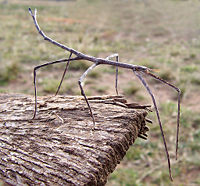Phasmatodea
- "Phasmid" redirects here. For the cloning vector used in genetics, see phagemid.
| Phasmatodea Fossil range: Eocene - Recent |
||||||||||||||
|---|---|---|---|---|---|---|---|---|---|---|---|---|---|---|
 Ctenomorpha chronus
|
||||||||||||||
| Scientific classification | ||||||||||||||
|
||||||||||||||
| Suborders | ||||||||||||||
|
Agathemerodea |
The Phasmatodea (sometimes called Phasmida) are an order of insects, whose members are variously known as stick insects (in Europe), walking sticks or stick-bugs (in the United States of America), phasmids, ghost insects and leaf insects (generally the family Phylliidae). The ordinal name is derived from the Greek "phasma" meaning an apparition or phantom, and refers to the resemblance of many species to sticks or leaves. Their natural camouflage can make them extremely difficult to spot. A few species (for example those in the genus Anisomorpha) are capable of secreting a substance from glands on the metathorax that can cause an intense burning irritation of the eyes (and in some cases temporary blindness) and mouth of potential predators on contact.
Contents |
Taxonomy
The classification of the Phasmatodea is complex. There are many people, including amateur entomologists, studying the order, and revisions are commonplace. The most authoritative source for information on the current taxonomy is the Phasmida Species File which is continually updated.
The Phasmatodea were considered a suborder of Orthoptera, although most authors now consider them to form an order of their own. There is much confusion over the ordinal name, with Phasmida being preferred by many authors, although it is incorrectly formed. Phasmatodea is correctly formed, and is gaining in popularity. Cheleutoptera is now considered outdated.
They are sometimes considered related to other orders, including the Blattaria, Mantodea, Notoptera and Dermaptera, but the affiliations are uncertain and the grouping (sometimes referred to as "Orthopteroidea") may be paraphyletic and hence invalid in the traditional circumscription.
Species
There are in excess of 3,000[1] described species, with many more yet to be described, both in museum collections, and in the wild. The order has a world-wide distribution, but most species are found in the tropics. These tropic species vary from stick like species to those resembling bark, leaves and even lichens.
Behaviour
Stick insects, like praying mantids, show rocking behaviour in which the insect makes rhythmic, repetitive side-to-side movements. Functions proposed for this behaviour include the enhancement of crypsis by means of the resemblance to vegetation moving in the wind. However the repetitive swaying movements may be most important in allowing the insects to discriminate objects from the background by their relative movement, a visual mechanism typical of simpler animals. Rocking movements by these generally sedentary insects may replace flying or running as a source of relative motion of objects in the visual field. [2]
Stick insects as pets
Many stick insects are easy to care for, and make good pets. Almost 300 species have been reared in captivity.[3]
The most commonly kept — the Indian (or Laboratory) stick insect, Carausius morosus, requires a tall (25+ cm) vivarium (even a jar with a few holes punched in the top), some bramble, ivy, privet and lettuce and an atmosphere at room temperature. Indian stick insects are all female and reproduce by parthenogenesis and seem content living on their own. Occasionally part-male part-female individuals are reared in captivity, but never true males. All stick insects moult and may eat the shed skin. By the sixth moult the Indian stick insect will lay eggs.
Many of the other species of phasmids kept in captivity will feed on bramble. However, some are very specialist feeders and are therefore more difficult to rear. Beginners often make the mistake of thinking all species will feed on privet (the plant most commonly used to feed the Indian stick insect), in fact few species feed on privet. Most of the privet feeders on the Phasmid Study Group's culture list belong to the family Pseudophasmatidae and are from South America, several of these will also feed on hebe. The few members of the family Aschiphasmatidae that have been reared have to be fed on fuchsia, willow herb, or evening primrose. Some of the species in the subfamily Necrosciinae will only feed on hypericum.
Notable species
One Australian species, the Lord Howe Island stick insect, is now listed as critically endangered. It was believed extinct until its rediscovery on the rock known as Ball's Pyramid. There is a large effort in Australia to rear this species in captivity.
Females of the genus Phobaeticus are the world's longest insects, measuring up to 33 cm (13 in) from head to tip of abdomen.[4]
Adult female Heteropteryx dilatata are likely to weigh up to 65 g, and captive bred specimens have been known to weigh in the order of 50 g.
The best known of the stick insects is the Indian or Laboratory stick insect (Carausius morosus). These insects grow to roughly 10 cm (4 inches). They reproduce parthenogenically and males are unrecorded, although part male part female gynandromorphs are relatively common.
Breeding
Stick insects are bred by using a light spray of water on the eggs and then waiting for them to hatch. A small paint brush is used to handle the young nymphs. Breeders must take extreme care to ensure that no pools of water are left in the vicinity where they could drown.
Additional images
References
- ↑ Bragg, P.E. (2001) Phasmids of Borneo, Natural History Publications (Borneo), Kota Kinabalu. - see p. 614
- ↑ O'Dea, JD. Eine zusatzliche oder alternative Funktion der 'kryptischen' Schaukelbewegung bei Gottesanbeterinnen und Stabschrecken (Mantodea, Phasmatodea). Entomologische Zeitschrift, 101, Nr. 1/2, 15 Januar 1991, 25-27.
- ↑ Bragg, P. (2008) Changes to the PSG Culture List, Phasmid Study Group Newsletter, 113: 4-5.
- ↑ BBC. [1] "At 56.6cm, the Phobaeticus chani (Chan's megastick) beats the previous record holder, another stick-insect, by more than one centimetre." Retrieved 2008-10-17
- Cameron, Stephen L.; Barker, Stephen C. & Whiting, Michael F. (2006): Mitochondrial genomics and the new insect order Mantophasmatodea. Molecular Phylogenetics and Evolution 38: 274–279. doi:10.1016/j.ympev.2005.09.020 (HTML abstract)